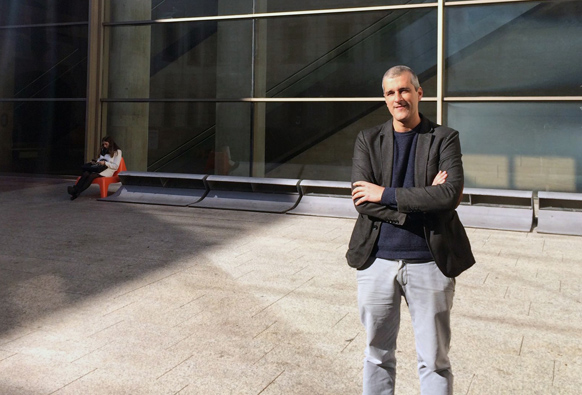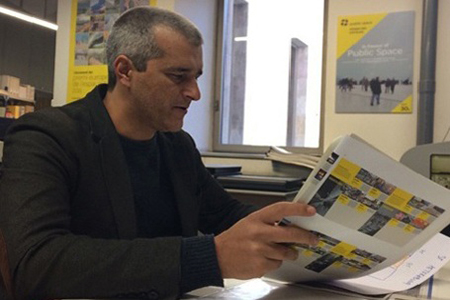Interview with David Bravo, architect and CCCB collaborator
What are the most worrying housing and urban development problems at worldwide scale? Do governments, businesses and institutions agree as to how to tackle them? Do cities have similar problems and conflicts? Habitat III, the third international conference on Housing and Sustainable Development, took place in Quito in October 2016. The UN holds this summit every 20 years to define what it calls the “New Urban Agenda”, the roadmap that states and organizations should follow as regards urban planning or development.
The architect David Bravo, a collaborator of the Centre de Cultura Contemporània in projects such as the European Prize for Urban Public Space or the exhibition Piso Piloto, of which he was co-curator, attended the summit on behalf of the CCCB. Carlota Broggi, head of the CCCB’s touring exhibitions, interviews David Bravo about his experience at Habitat III.
The need to understand housing as a right, to democratize cities and distance them from the interests of big business, gentrification or the acritical discourse surrounding so-called smart cities are common themes that concern Barcelona and Quito, and which David comments on in this interview.
- What was the point of the CCCB’s presence in Quito?
- Habitat III, the UN Conference on Housing and Sustainable Urban Development, brought together in Quito activists, thinkers and governors from all over the planet to establish the guidelines for the New Urban Agenda. The importance of this meeting is reflected in the fact that it only takes place once every 20 years. The CCCB’s presence highlighted its reflection on the urban phenomenon, which has been a part of the institution’s DNA since it was created. The CCCB has always taken an across-the-board view of the city and strived to combine such diverse disciplines as philosophy, literature, politics and urban planning. This promiscuity was particularly appropriate in the context of Quito, where voices from very differing geographical and disciplinary backgrounds made themselves heard.
- How has the debate generated at Habitat III changed your view of architecture and urban design as tools to regenerate the city?
More than changing my view, it confirmed my belief that architecture and urban planning are double-edged swords. They can serve the abuse of power by contributing to spatial injustice, property speculation, corruption in planning, public debt, wasting energy or concentrating wealth in the hands of the few. But they are also vital instruments for democracy.
Rather than regeneration, we need to talk about the democratization of the city. Too often, we are victims of a dazzling neophilia that leads us to assume that all regeneration is positive. But this is not always the case; regeneration often means breaking up a social and urban fabric, damaging its values, and excluding or casting out its disadvantaged inhabitants. So we have to politicize our judgment of urban transformation, which is never a purely technical or aesthetic question. Democratizing transformations are those that improve the life in common of those who share the city today—justice—and the survival of those who will inherit it tomorrow—sustainability—. If these two conditions are not met, we are not building democracy.
“We have to politicize our judgment of urban transformation”
- The summit invited mayors from around the world, as well as heads of management and governability. Is there a consensus that views housing as a basic need and a collective phenomenon, like public space?
- No, by no means. There is a big polarization between those who see housing as an asset and prioritize the right to ownership and those who see housing above all as a basic right and a means to democratize the city. This polarization manifests itself in various ways. The Thematic meetings held previously in various cities to prepare the Quito summit—Barcelona held one in April—produced official declarations full of alerts as to “spatial injustice” and defending the “right to the city”, concepts that were also very much present in Quito, both at the summit’s networking events and the alternative forums held alongside it. However, some UN member states reject the use of these concepts. So much so that the summit’s final declaration, as political scientist Joan Subirats remarked, is full of commercial concepts such as “smart city” while avoiding the word “democracy” and making just one, very indirect, reference to the “right to the city”.
- The need to invest in smart cities was incorporated into the housing and urban design debate some years ago now. What does this concept really mean, and how did it feature in Quito?
- My main objection to the smart city current is that it places the means before the ends. You might say that it contradicts the Machiavellian thesis that “the end justifies the means”, defending instead that “the means justifies the end”, an equally mistaken statement. The smart city often presents solutions to irrelevant or non-existing problems, while avoiding solutions to the two principal problems rife in all cities: injustice and foolishness. To give one example, we don’t need sensors that allow us to find a parking space more quickly; what we do need is to produce cities that can once again function without such an unjust and unsustainable invader as the private vehicle, be it electric or self-driving.
The smart city views the urban phenomenon from the viewpoint of highly depoliticized, acritical technophilia even as it forgets—or conceals—that any urban transformation has political causes and effects—politics comes from polis, which means city! And it does this in collusion with big global corporations of doubtful reputation, like Cisco Systems or Telefónica, which concentrate great wealth in the hands of the few. Recently there has also been talk of “smart citizens”, which seems like a bit of an attempt to give a facelift to an initiative that originally overlooked the people. They is no denying that new technologies can be very useful in improving transparency, participation, collaborative coproduction or the democratic management of cities. But we have to remember that technology is just an instrument that can equally be used to serve democracy or the abuse of power.
“The smart city offers solutions to irrelevant or non-existing problems, while avoiding solutions to the two principal problems rife in all cities: injustice and foolishness”
- As a representative of the CCCB, what contribution to the general debate were you able to make at the round tables organized at Habitat III?
Most particularly, the lessons learned from the European Prize for Urban Public Space—organized since 2000 by the CCCB along with another six institutions in Frankfurt, Helsinki, Ljubljana, London, Paris and Vienna—and the reflections offered by the exhibition Piso Piloto, organized jointly by the CCCB and the Museo de Antioquia in Medellin, which explores a host of solutions that have proven their viability for implementing the right to housing and the right to the city.
- Do you think these reflections evolved during the work sessions in Quito?
- The reflections underlying Piso Piloto evolved, because they showed that, beyond the immediate context of the exhibition—the cities of Barcelona and Medellin—they are just as relevant in other settings, such as Equatorial or Mexican cities. Quito and Mexico City are also concerned about phenomena such as gentrification, the lack of social housing or the proliferation of large private developments that impoverish the urban fabric and isolate their residents in closed communities. Ultimately, we see that the right to housing and the right to the city are universal and cannot be taken apart from each other. I’d go so far as to say that in an increasingly urbanized world, these rights are the bedrock of the rest of our human rights.
- If Piso Piloto argues that “the city of the future is already built”, why do you think it is useful to discuss the challenges of urbanization in the 21st century?
- When we say that “the city of the future is already built”, we don’t mean that there’s nothing left to be done, or propose that things should be left as they are. What we want is to get past the development paradigm of the 20th century, based on unlimited growth. Past the utopian logic of modern urbanism that prefers the clean slate or the new build to grappling with the complexity of a pre-existing place. Past compulsively extending urban land with mono-functional, low-density new builds. Past an outdated, highly unjust and unsustainable model that’s responsible for urban sprawl, spatial segregation, pollutant emissions, energy waste and territorial depredation.
And this is not nostalgia; it’s a really contemporary way of thinking to defend the pre-modern model of the mixed compact city, made up of small row properties, with corridor-streets that encourage local commerce, a mix of uses and social classes, pedestrian movement and the possibility of good, efficient public transport. This model is far more appropriate for dealing with the economic, ecological and political challenges of the immediate future.
- Ideally, what is the best Urban Agenda for the coming years?
- As I see it, the Urban Agenda should be a firm commitment to inundate cities with democratic radicalism. And I don’t mean playing to the gallery; it has to take the form of specific, verifiable measures. Any urban transformation has to democratize the city in four principal directions:
1. Looking downwards, there’s the principle of redistribution that conveys wealth and opportunities to the base of the social pyramid. We have to democratize access to basic resources and important places, combat growing inequalities and understand that social cohesion is a necessary condition for the good functioning of any city.
2. Looking forwards, we have sustainability, which improves the legacy we leave for coming generations. We have to stop putting them in the red, stop squandering the energy resources that they will need or damaging the environment in which they will live. Promoting sensible ways of designing the city is the most effective way of combatting climate change.
3. Looking back, there is the value of memory, which draws the best lessons from the past so that each generation can progress from the best starting point. We have to fill in the gaps available in compact fabrics, activate the things we have inherited from the past with new uses and meanings that preserve their heritage values. Reform, recycle, reuse and re-inhabit what is built rather than destroying, replacing or building anew.
4. Looking up, there’s the idea of participation—bottom-up—, that allows us to combat technocracy, populism, cronyism and abuse of power. We have to use pedagogy, transparency and accountability to transform the indifferent and the selfish into responsible, rigorous, aware citizens who are involved and empowered.









